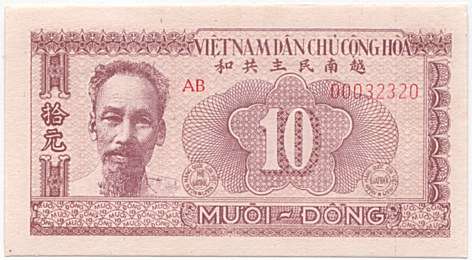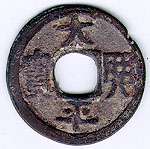North Vietnamese đồng
| North Vietnamese đồng | |||||
|---|---|---|---|---|---|
| đồng Việt Nam Dân Chủ Cộng Hòa (Vietnamese) | |||||
| |||||
| Denominations | |||||
| Subunit | |||||
| 1⁄10 | hào | ||||
| 1⁄100 | xu | ||||
| Symbol | ₫ | ||||
| Banknotes | 2, 5 xu, 1, 2, 5 hào, 1, 2, 5, 10 đồng | ||||
| Coins | 1, 2, 5 xu | ||||
| Demographics | |||||
| User(s) |
| ||||
| Issuance | |||||
| Central bank | National Bank of Vietnam and State Bank of Vietnam | ||||
| Website |
www | ||||
|
This infobox shows the latest status before this currency was rendered obsolete. | |||||
The đồng (/ˈdɒŋ/; Vietnamese: [ɗôŋm]) was the currency of North Vietnam from 3 November 1946 to 2 May 1978. It was subdivided into 10 hào, each itself divided into 10 xu.
History
The first đồng issued by the communists controlling northern Vietnam was introduced on January 31, 1946, and replaced the French Indochinese piastre at par. Two revaluations followed. In 1951, the second đồng was introduced at a rate of 1 1951 đồng = 100 1946 đồng. However, some sources say there were two consecutive revaluations in 1951 and 1953, each with factor of 10. In 1954, this became the currency of the newly recognized state of North Vietnam, with an exchange rate to the still circulating piastre and South Vietnamese đồng of 32 northern đồng = 1 piastre or southern đồng. In 1956, the đồng was pegged to the Chinese renminbi yuan at a rate of 1.47 đồng = 1 yuan.
On 28 February 1959, another đồng replaced the second at a rate of 1 1959 đồng = 1000 1951 đồng. An exchange rate with the Soviet ruble was established in 1961, with 3.27 đồng = 1 ruble. On May 3, 1978, following the unification of Vietnam, the đồng was also unified. 1 new đồng = 1 northern đồng = 0.8 southern "liberation" đồng.
Coins
1946 đồng
In 1946, aluminium 20 xu, 5 hào and 1 đồng and bronze 2 đồng were issued, with the 20 xu coins dated 1945. These were the only coins issued for this currency, with no coins at all issued for the 1951 đồng.
| Coins of the North Vietnamese đồng – 1946 issue | |||||||||||||
|---|---|---|---|---|---|---|---|---|---|---|---|---|---|
| Obverse | Reverse | Denomination | Composition | Obverse | Reverse | ||||||||
| 20 xu | aluminium | Star | Denomination | ||||||||||
| 5 hào | aluminium | Ceremonial urn | Denomination | ||||||||||
| 1 đồng | aluminium | Hồ Chí Minh | Denomination | ||||||||||
| 2 đồng | bronze | Hồ Chí Minh | Star; denomination | ||||||||||
1958 đồng
In 1958, holed, aluminium coins in denominations of 1, 2 and 5 xu were introduced. These were the only coins issued in this currency.
| Coins of the North Vietnamese đồng – 1958 issue | |||||||||||||
|---|---|---|---|---|---|---|---|---|---|---|---|---|---|
| Obverse | Reverse | Denomination | Composition | Obverse | Reverse | ||||||||
| 1 xu | Aluminium | An emblem similar in design to the coat of arms of North Vietnam; Nước Việt Nam Dân Chú Cộng Hòa | Ngân Hàng Quốc Gia Việt Nam; denomination; date | ||||||||||
| 2 xu | Aluminium | emblem similar in design to the coat of arms of North Vietnam; Nước Việt Nam Dân Chú Cộng Hòa | Ngân Hàng Quốc Gia Việt Nam; denomination; date | ||||||||||
| 5 xu | Aluminium | emblem similar in design to the coat of arms of North Vietnam; Nước Việt Nam Dân Chú Cộng Hòa | Ngân Hàng Quốc Gia Việt Nam; denomination; date | ||||||||||
Banknotes
1946 đồng
The government (Việt Nam Dân Chủ Cộng Hòa) issued two forms of paper money for this currency, "Vietnamese banknotes" (Giấy Bạc Việt Nam) and "Credit notes" (Tín Phiếu). In 1946, banknotes were introduced in denominations of 20 and 50 xu, 1, 5, 20, 50, 100 đồng, together with credit notes for 1 đồng. These were followed in 1948 by banknotes for 10 đồng and credit notes for 20 đồng, in 1949 by 500 đồng banknotes and 5 and 50 đồng credit notes, and in 1950 by 200 đồng banknotes and 100, 500 and 1000 đồng credit notes.
1951 đồng
In 1951, the National Bank of Vietnam (Ngân hàng quốc gia Việt Nam) introduced notes for 20, 50, 100, 200, 500 and 1000 đồng, with 5000 đồng notes added in 1953. These were the only circulating currency between 1951 and 1958.
1959 đồng
In 1958, the National Bank introduced notes for 1 xu, 1, 2 and 5 hào, 1, 2, 5 and 10 đồng, with the 1 xu notes an overprint on an earlier, unissued type of 10 đồng note. In 1964, the State Bank of Vietnam (Ngân hàng Nhà nước Việt Nam) introduced 2 xu notes, followed by 5 xu, 1 and 2 hào in 1975.
See also
Gallery
 10 Dong (1951), front
10 Dong (1951), front 10 Dong (1951), back
10 Dong (1951), back 500 Dong (1951), front
500 Dong (1951), front 500 Dong (1951), back
500 Dong (1951), back 1000 Dong (1951), front
1000 Dong (1951), front 1000 Dong (1951), back
1000 Dong (1951), back 1 Dong (1958), front
1 Dong (1958), front 1 Dong (1958), back
1 Dong (1958), back 10 Dong (1958), front
10 Dong (1958), front 10 Dong (1958), back
10 Dong (1958), back
References
- Howard A. Daniel, III (1995) Democratic Republic of Vietnam Coins and Currency. ISBN 1-879951-03-7
- Krause, Chester L.; Clifford Mishler (1991). Standard Catalog of World Coins: 1801–1991 (18th ed.). Krause Publications. ISBN 0873411501.
- Pick, Albert (1994). Standard Catalog of World Paper Money: General Issues. Colin R. Bruce II and Neil Shafer (editors) (7th ed.). Krause Publications. ISBN 0-87341-207-9.
External links
| Wikimedia Commons has media related to Banknotes of Vietnam - 1951 Issue. |
| Preceded by: French Indochinese piastre, Vietnamese cash[1] Location: French Indochina Reason: independence Ratio: at par (piastre) 20 văn = 1 đồng (cash) |
Currency of North Vietnam 1946 – 1951 |
Succeeded by: 1951 đồng Reason: inflation Ratio: 1 1951 đồng = 100 1946 đồng Note: some sources say there were 2 consecutive revaluations in 1951 and 1953, each with factor of 10 |
| Preceded by: 1946 đồng Reason: inflation Ratio: 1 1951 đồng = 100 1946 đồng Note: some sources say there were 2 consecutive revaluations in 1951 and 1953, each with factor of 10 |
Currency of North Vietnam 1951 – 1959 |
Succeeded by: 1959 đồng Reason: inflation Ratio: 1 1959 đồng = 1000 1951 đồng |
| Preceded by: 1951 đồng Reason: inflation Ratio: 1 1959 đồng = 1000 1951 đồng |
Currency of North Vietnam (until 1976) Northern Vietnam (from 1976) 1959 – 1978 |
Succeeded by: Vietnamese đồng Location: Vietnam Reason: currency unification Ratio: at par |
- ↑ "Sapeque and Sapeque-Like Coins in Cochinchina and Indochina (交趾支那和印度支那穿孔錢幣)". Howard A. Daniel III (The Journal of East Asian Numismatics – Second issue). 20 April 2016. Retrieved 10 December 2017.


_Art-Hanoi_02.jpg)
_02.jpg)